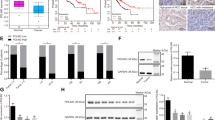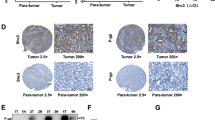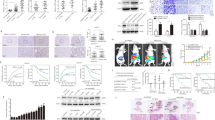Abstract
Aberrant activation of the Wnt/β-catenin pathway is frequent in hepatocellular carcinoma (HCC) and contributes to HCC initiation and progression. This abnormal activation may result from somatic mutations in the genes of the Wnt/β-catenin pathway and/or dysregulation of the Wnt/β-catenin pathway. The mechanism for the latter remains poorly understood. Prospero-related homeobox 1 (PROX1) is a downstream target of the Wnt/β-catenin pathway in human colorectal cancer and elevated PROX1 expression promotes malignant progression. However, the Wnt/β-catenin pathway does not regulate PROX1 expression in the liver and HCC cells. Here we report that PROX1 promotes HCC cell proliferation in vitro and tumor growth in HCC xenograft mice. PROX1 and β-catenin levels are positively correlated in tumor tissues as well as in cultured HCC cells. PROX1 can upregulate β-catenin transcription by stimulating the β-catenin promoter and enhance the nuclear translocation of β-catenin in HCC cells, which leads to the activation of the Wnt/β-catenin pathway. Moreover, we show that increase in PROX1 expression renders HCC cells more resistant to sorafenib treatment, which is the standard therapy for advanced HCC. Overall, we have pinpointed PROX1 as a critical factor activating the Wnt/β-catenin pathway in HCC, which promotes HCC proliferation and sorafenib resistance.
This is a preview of subscription content, access via your institution
Access options
Subscribe to this journal
Receive 50 print issues and online access
$259.00 per year
only $5.18 per issue
Buy this article
- Purchase on Springer Link
- Instant access to full article PDF
Prices may be subject to local taxes which are calculated during checkout







Similar content being viewed by others
References
Ferlay J, Shin HR, Bray F, Forman D, Mathers C, Parkin DM . Estimates of worldwide burden of cancer in 2008: GLOBOCAN 2008. Int J Cancer 2010; 127: 2893–2917.
Llovet JM, Ricci S, Mazzaferro V, Hilgard P, Gane E, Blanc JF et al. Sorafenib in advanced hepatocellular carcinoma. N Engl J Med 2008; 359: 378–390.
Clevers H . Wnt/beta-catenin signaling in development and disease. Cell 2006. 469–480.
Takigawa Y, Brown AM . Wnt signaling in liver cancer. Curr Drug Targets 2008; 9: 1013–1024.
Boyault S, Rickman DS, de Reyniès A, Balabaud C, Rebouissou S, Jeannot E et al. Transcriptome classification of HCC is related to gene alterations and to new therapeutic targets. Hepatology 2007; 45: 42–52.
de La Coste A, Romagnolo B, Billuart P, Renard CA, Buendia MA, Soubrane O et al. Somatic mutations of the beta-catenin gene are frequent in mouse and human hepatocellular carcinomas. Proc Natl Acad Sci USA 1998; 95: 8847–8851.
Satoh S, Daigo Y, Furukawa Y, Kato T, Miwa N, Nishiwaki T et al. AXIN1 mutations in hepatocellular carcinomas, and growth suppression in cancer cells by virus-mediated transfer of AXIN1. Nat Genet 2000; 24: 245–250.
Cui J, Zhou X, Liu Y, Tang Z . Mutation and overexpression of the beta-catenin gene may play an important role in primary hepatocellular carcinoma among Chinese people. J Cancer Res Clin Oncol 2001; 127: 577–581.
Lai TY, Su CC, Kuo WW, Yeh YL, Kuo WH, Tsai FJ et al. β-catenin plays a key role in metastasis of human hepatocellular carcinoma. Oncol Rep 2011; 26: 415–422.
Guigon CJ, Kim DW, Zhu X, Zhao L, Cheng SY . Tumor suppressor action of liganded thyroid hormone receptor beta by direct repression of beta-catenin gene expression. Endocrinology 2010; 151: 5528–5536.
Li Q, Dashwood WM, Zhong X, Al-Fageeh M, Dashwood RH . Cloning of the rat beta-catenin gene (Ctnnb1) promoter and its functional analysis compared with the Catnb and CTNNB1 promoters. Genomics 2004; 83: 231–242.
Liu G, Jiang S, Wang C, Jiang W, Liu Z, Liu C et al. Zinc finger transcription factor 191, directly binding to beta-catenin promoter, promotes cell proliferation of hepatocellular carcinoma. Hepatology 2012; 55: 1830–1839.
Riazi AM, Takeuchi JK, Hornberger LK, Zaidi SH, Amini F, Coles J et al. NKX2-5 regulates the expression of beta-catenin and GATA4 in ventricular myocytes. PLoS One 2009; 4: e5698.
Chai H, Luo AZ, Weerasinghe P, Brown RE . Sorafenib downregulates ERK/Akt and STAT3 survival pathways and induces apoptosis in a human neuroblastoma cell line. Int J Clin Exp Pathol 2010; 3: 408–415.
Han L, Yang Y, Yue X, Huang K, Liu X, Pu P et al. Inactivation of PI3K/AKT signaling inhibits glioma cell growth through modulation of beta-catenin-mediated transcription. Brain Res 2010; 1366: 9–17.
Lachenmayer A, Alsinet C, Savic R, Cabellos L, Toffanin S, Hoshida Y et al. Wnt-pathway activation in two molecular classes of hepatocellular carcinoma and experimental modulation by sorafenib. Clin Cancer Res 2012; 18: 4997–5007.
Burke Z, Oliver G . Prox1 is an early specific marker for the developing liver and pancreas in the mammalian foregut endoderm. Mech Dev 2002; 118: 147–155.
Dyer MA, Livesey FJ, Cepko CL, Oliver G . Prox1 function controls progenitor cell proliferation and horizontal cell genesis in the mammalian retina. Nat Genet 2003; 34: 53–58.
Hong YK, Harvey N, Noh YH, Schacht V, Hirakawa S, Detmar M et al. Prox1 is a master control gene in the program specifying lymphatic endothelial cell fate. Dev Dyn 2002; 225: 351–357.
Kaltezioti V, Kouroupi G, Oikonomaki M, Mantouvalou E, Stergiopoulos A, Charonis A et al. Prox1 regulates the notch1-mediated inhibition of neurogenesis. PLoS Biol 2010; 8: e1000565.
Lavado A, Oliver G . Prox1 expression patterns in the developing and adult murine brain. Dev Dyn 2007; 236: 518–524.
Risebro CA, Searles RG, Melville AA, Ehler E, Jina N, Shah S et al. Prox1 maintains muscle structure and growth in the developing heart. Development 2009; 136: 495–505.
Sosa-Pineda B, Wigle JT, Oliver G . Hepatocyte migration during liver development requires Prox1. Nat Genet 2000; 25: 254–255.
Elsir T, Smits A, Lindstrom MS, Nister M . Transcription factor PROX1: its role in development and cancer. Cancer Metastasis Rev 2012; 31: 793–805.
Liu Y, Zhang JB, Qin Y, Wang W, Wei L, Teng Y et al. PROX1 promotes hepatocellular carcinoma metastasis by way of up-regulating hypoxia-inducible factor 1alpha expression and protein stability. Hepatology 2013; 58: 692–705.
Kamiya A, Kakinuma S, Onodera M, Miyajima A, Nakauchi H . Prospero-related homeobox 1 and liver receptor homolog 1 coordinately regulate long-term proliferation of murine fetal hepatoblasts. Hepatology 2008; 48: 252–264.
Karalay O, Doberauer K, Vadodaria KC, Knobloch M, Berti L, Miquelajauregui A et al. Prospero-related homeobox 1 gene (Prox1) is regulated by canonical Wnt signaling and has a stage-specific role in adult hippocampal neurogenesis. Proc Natl Acad Sci U S A 2011; 108: 5807–5812.
Petrova TV, Nykanen A, Norrmen C, Ivanov KI, Andersson LC, Haglund C et al. Transcription factor PROX1 induces colon cancer progression by promoting the transition from benign to highly dysplastic phenotype. Cancer Cell 2008; 13: 407–419.
Qin J, Gao DM, Jiang QF, Zhou Q, Kong YY, Wang Y et al. Prospero-related homeobox (Prox1) is a corepressor of human liver receptor homolog-1 and suppresses the transcription of the cholesterol 7-alpha-hydroxylase gene. Mol Endocrinol 2004; 18: 2424–2439.
Song KH, Li T, Chiang JY . A Prospero-related homeodomain protein is a novel co-regulator of hepatocyte nuclear factor 4alpha that regulates the cholesterol 7alpha-hydroxylase gene. J Biol Chem 2006; 281: 10081–10088.
Ouyang HF, Qin Y, Liu YF, Xie YH, Liu J . Prox1 directly interacts with LSD1 and recruits the LSD1/NuRD complex to epigenetically co-repress CYP7A1 transcription. PLOS One 2013; 8: e62192.
Klaus A, Birchmeier W . Wnt signalling and its impact on development and cancer. Nat Rev Cancer 2008; 8: 387–398.
Iyer R, Fetterly G, Lugade A, Thanavala Y . Sorafenib: a clinical and pharmacologic review. Expert Opin Pharmacother 2010; 11: 1943–1955.
Zhu XD, Zhang JB, Zhuang PY, Zhu HG, Zhang W, Xiong YQ et al. High expression of macrophage colony-stimulating factor in peritumoral liver tissue is associated with poor survival after curative resection of hepatocellular carcinoma. J Clin Oncol 2008; 26: 2707–2716.
Ye QH, Qin LX, Forgues M, He P, Kim JW, Peng AC et al. Predicting hepatitis B virus-positive metastatic hepatocellular carcinomas using gene expression profiling and supervised machine learning. Nat Med 2003; 9: 416–423.
Acknowledgements
We thank Prof RH Dashwood of Oregon State University and Prof Long Yu of Fudan University for kindly providing the β-catenin promoter luciferase reporters. This work is supported by the grants from the National Key Project for Infectious Diseases (2012ZX10002-006, 2012ZX10004-503, 2012ZX10002012-003), National Basic Research Program (2012CB519002), Natural Science Foundation of China (31071143, 31170148, 81472226, 81372654 and 81370730), Shanghai Municipal Health Committee (GWDTR201216), Nature Science Foundation from Shandong province (ZR2011HQ006) and Municipal Science and Technology Committee (13ZR1407100).
Author information
Authors and Affiliations
Corresponding authors
Ethics declarations
Competing interests
The authors declare no conflict of interest.
Additional information
Supplementary Information accompanies this paper on the Oncogene website
Supplementary information
Rights and permissions
About this article
Cite this article
Liu, Y., Ye, X., Zhang, JB. et al. PROX1 promotes hepatocellular carcinoma proliferation and sorafenib resistance by enhancing β-catenin expression and nuclear translocation. Oncogene 34, 5524–5535 (2015). https://doi.org/10.1038/onc.2015.7
Received:
Revised:
Accepted:
Published:
Issue Date:
DOI: https://doi.org/10.1038/onc.2015.7
This article is cited by
-
Prox1 Suppresses Proliferation and Drug Resistance of Retinoblastoma Cells via Targeting Notch1
Current Medical Science (2024)
-
AMPK induces degradation of the transcriptional repressor PROX1 impairing branched amino acid metabolism and tumourigenesis
Nature Communications (2022)
-
Circ_0007534 Silencing Inhibits the Proliferation, Migration and Invasion and Induces the Apoptosis of Glioma Cells Partly Through Down-Regulating PROX1 Via Elevating miR-22-3p Level
Cellular and Molecular Neurobiology (2022)
-
Prox1 inhibits neurite outgrowth during central nervous system development
Cellular and Molecular Life Sciences (2021)
-
TRIM25 promotes the cell survival and growth of hepatocellular carcinoma through targeting Keap1-Nrf2 pathway
Nature Communications (2020)



